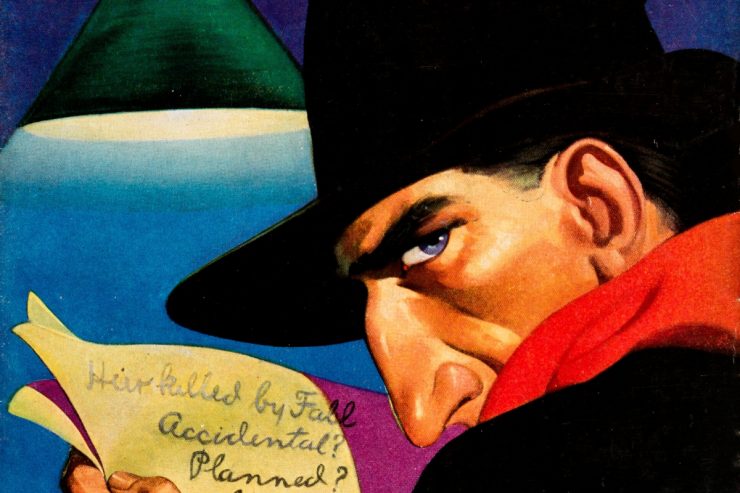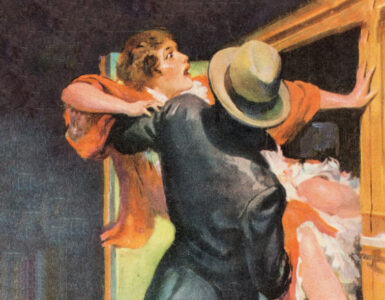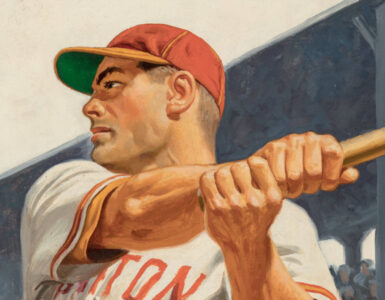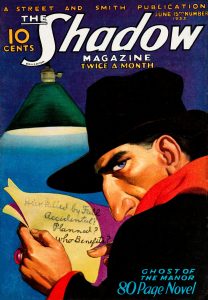 The Shadow was introduced to the public on July 31, 1930. The character was the mysterious narrator for THE DETECTIVE STORY HOUR, a CBS radio program sponsored by the Street & Smith pulp chain.
The Shadow was introduced to the public on July 31, 1930. The character was the mysterious narrator for THE DETECTIVE STORY HOUR, a CBS radio program sponsored by the Street & Smith pulp chain.
When the publisher’s business manager, Henry Ralston, began to hear from newsdealers that their customers were not asking for DETECTIVE STORY MAGAZINE, but “that Shadow magazine,” he decided that the time might be ripe for the revival of the single-character magazine.
THE SHADOW: A DETECTIVE MAGAZINE was launched on March 6, 1931, and the rest is history. In “The Living Shadow,” author Walter B. Gibson refashioned the sinister narrator of THE DETECTIVE STORY HOUR into the first pulp hero. Within a year, the magazine began appearing twice a month. Within two years, it began spawning a host of imitators — THE PHANTOM DETECTIVE, THE SPIDER, SECRET AGENT “X,” and Street & Smith’s own DOC SAVAGE MAGAZINE and THE AVENGER. But The Shadow was not just the first pulp hero. He was also the big true multi-media hero.
The first issue of Street & Smith’s THE SHADOW: A DETECTIVE MAGAZINE had been on the nation’s newsstands for only a couple of months when Universal Pictures announced their upcoming releases. Among the 104 short subjects named for 1931 – 32 issuance were thirteen “Shadow Detective” featurettes. These “two-reelers” had no connection to The Shadow’s pulp adventures; they were to be adaptations of episodes from radio’s THE DETECTIVE STORY HOUR.
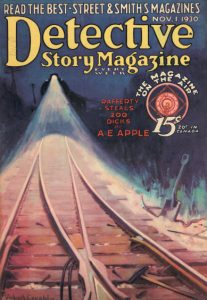 Historically, The Shadow was created by writer Harry Charlot to host the Street & Smith sponsored radio program. As the omnipotent narrator, The Shadow’s periodic interjections were designed as scene transitions. His declarations that “Crime does not pay,” were calculated to frighten potential malefactors.
Historically, The Shadow was created by writer Harry Charlot to host the Street & Smith sponsored radio program. As the omnipotent narrator, The Shadow’s periodic interjections were designed as scene transitions. His declarations that “Crime does not pay,” were calculated to frighten potential malefactors.
Several actors played the character in the show’s early months, but Frank Readick’s sepulchral tones resonated the best with listeners. THE DETECTIVE STORY HOUR quickly became a national sensation — not so much for the individual stories, but for The Shadow himself, whose creepy laughter sent chills up the spines of people huddled around their radios.
Silent movies, of course, would not have been the proper medium for screen adaptations of such adventures, but the relatively new talking pictures were ideal for such a purpose. The two-reeler (with its running time of 18 to 22 minutes) seemed appropriate, length-wise, for translating radio adaptations to celluloid.
Our first Shadow featurette was shot in Universal’s New York studio; the cast members were all Broadway actors. A BURGLAR TO THE RESCUE was based on the DETECTIVE STORY MAGAZINE short story of the same title by Herman Landon. Written and directed by George Cochrane, it concerns a small-town banker, who has been appropriating funds from the vault. One night, he is visited by a gun-wielding intruder. The visitor is a former teller whom the president had framed to cover his own pilfering. The truth is revealed and justice prevails, proving that — as The Shadow intones — “Crime does not pay.”
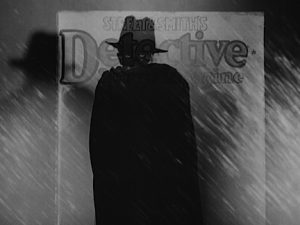 The significance of A BURGLAR TO THE RESCUE is twofold. To begin with, the character is visualized for the first time, superimposed over a DETECTIVE STORY MAGAZINE cover. He wears a black fedora and long cloak, with a domino mask partially covering his features. So A BURGLAR TO THE RESCUE scores points on the basis of iconographic evolution.
The significance of A BURGLAR TO THE RESCUE is twofold. To begin with, the character is visualized for the first time, superimposed over a DETECTIVE STORY MAGAZINE cover. He wears a black fedora and long cloak, with a domino mask partially covering his features. So A BURGLAR TO THE RESCUE scores points on the basis of iconographic evolution.
More importantly, however, The Shadow’s voice in this film is obviously that of Frank Readick. Since his DETECTIVE STORY HOUR episodes are all lost to the ages, this humble two-reeler gives present-day Shadow fans their only opportunity to hear him in character, to appreciate the sinister cackling that defined The Shadow for millions of listeners. It was also the laugh referenced by Gibson for the pulp novels.
Our feature film for the night is the Lynn Shores directed film, THE SHADOW STRIKES. Released in 1937 by Grand National Films, this black and white film stars Rod La Rocque as Lamont Granston, also known as The Shadow. Loosely based on Walter B. Gibson’s “The Ghost of the Manor,” originally published in the June 15, 1933 issue of THE SHADOW MAGAZINE, it was adapted to the silver screen by Al Martin and Rex Taylor.
According to IMDb film reviewer Snow Leopard:
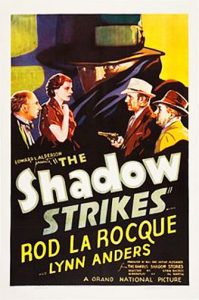 This is a fast-paced B feature with Rod La Rocque, in the role of “The Shadow,” getting involved in a fairly interesting and unpredictable mystery. In several respects, it doesn’t really have the expected feel that goes with The Shadow, but in itself, it’s not bad at all. La Rocque works all right as a mild-mannered, secretive hero, with his manner and even-toned voice conveying calm.
This is a fast-paced B feature with Rod La Rocque, in the role of “The Shadow,” getting involved in a fairly interesting and unpredictable mystery. In several respects, it doesn’t really have the expected feel that goes with The Shadow, but in itself, it’s not bad at all. La Rocque works all right as a mild-mannered, secretive hero, with his manner and even-toned voice conveying calm.
The story starts with “The Shadow” breaking up what seems to be just another petty crime, but quickly becoming involved in a wider and more serious mystery. La Rocque must assume additional extra identities, playing a risky game with the various suspects and witnesses. La Rocque’s restrained style makes it come off naturally enough, and while the rest of the characters are mostly one-dimensional, there is enough going on to keep things interesting. While it has a noticeably different feel from The Shadow of the pulps or radio, in itself it’s a fairly entertaining way to pass an hour for anyone who enjoys these old B-movies.
On Thursday, August 19, join PulpFest 2021 for the first part of “The Shadow on the Silver Screen.” Beginning at 11:15 PM at the DoubleTree by Hilton Hotel Pittsburgh – Cranberry, we’ll be showing A BURGLAR TO THE RESCUE, followed by THE SHADOW STRIKES. It’s the first segment of our three-part Shadow film festival.
The general public is welcome to attend our evening programming events. To learn more about our programming schedule, please click the Programming button at the top of this page.
For those who also want to enjoy our dealers’ room, you can join PulpFest by clicking the Registration button at the top of this page. And don’t forget to book a room at the DoubleTree. They’re going fast!
The first Shadow feature film, THE SHADOW STRIKES, was loosely based on Walter B. Gibson’s novel, “The Ghost of the Manor.” It originally appeared in the June 15, 1933 issue of THE SHADOW MAGAZINE, featuring front cover art by George Rozen.
The first film to visualize a character called The Shadow was Universal’s featurette, A BURGLAR TO THE RESCUE. Wearing a black fedora and long cloak, with a domino mask partially covering his features, The Shadow is superimposed over a DETECTIVE STORY MAGAZINE cover.
A BURGLAR TO THE RESCUE is based on the Herman Landon story of the same title. It originally appeared in the November 1, 1930 number of Street & Smith’s DETECTIVE STORY MAGAZINE. The cover art is by John A. Coughlin.

